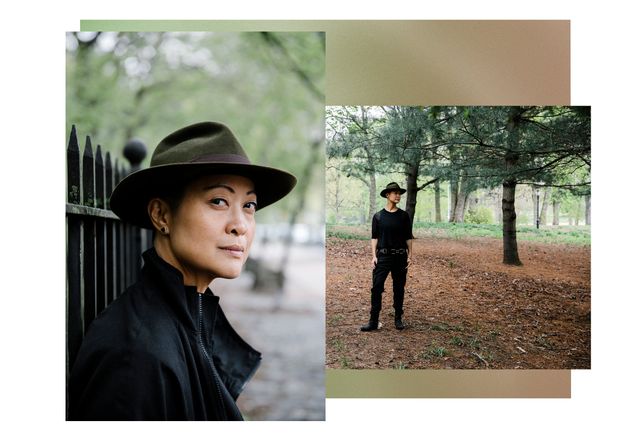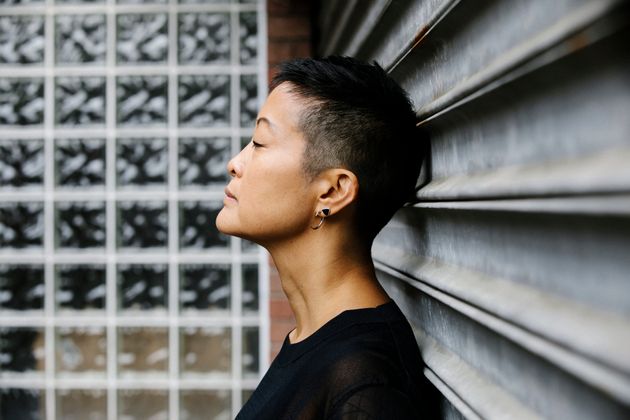
Photos by Laurel Golio
Yin Q is a former dominatrix and an educator and practitioner of bondage, discipline, dominance, submission and sadomasochism. For Q, BDSM has long been a part of their understanding of and experience with their sexuality.
Q, who uses they/them pronouns, discovered something compelling about the push-and-pull dynamics of BDSM during their sexual awakening. Their curiosity about it, and their identification with the practice and the community, only evolved and intensified as they got older.
Q initially explored kink as a cabaret performer in college. They wrote their college thesis on BDSM and eventually moved to the San Francisco Bay Area to apprentice and learn more about the leather community.
Today, Q ― now based in Brooklyn, New York ― uses their expertise and platform as an active, visible, queer Asian American person in the BDSM community to elevate the experiences of marginalised people, perform BDSM rituals with clients as a form of therapy and host workshops for members of the LGBTQ community. They are also the creator of the web series Mercy Mistress, which is co-produced by Margaret Cho and is based on Q’s time as a dominatrix.
Q, 44, chatted with HuffPost about how they use their work to highlight underserved communities, how they understand BDSM’s role in exploring and furthering queer pride and how they envision the future of the LGBTQ movement.
Now that you’re no longer working as a dominatrix, how does BDSM function in the ritual sessions that you offer?
The ritual work uses BDSM activities as well as sadomasochism ― whether it’s flogging, spanking, caning, fetish worship ― to be a cathartic release, or I use it as a sort of arena to work on something one might be going through. [The individual I’m working with] is not looking to get turned on by me, and I’m not looking to dominate someone in the way where they’re handing power over to me and manifesting like a fantasy play.
Tell me more about how one of your sessions actually works.
What I’m doing is actually just offering my skills and services to be the hand that puts someone into bondage, to hold safe space for them ― not to prod or poke them. It’s more that they would take a flogging for themselves, so if they’re going to take a really hard whipping, it’s so we can manifest something, or go with the intention that they’re trying to get through some kind of struggle ― whether it be work-related or any other part of their lives where they feel they need that physical push, much in the way someone might, say, run a marathon.

You also hold BDSM workshops specifically for queer people. Why?
For people to feel safe. The last time I looked on FetLife [an online community for people with/interested in fetishes and kink], within the hundreds of different identities and fetishes you can check off in terms of negotiation, there were still so many heteronormative identifiers that didn’t have the other queer identifier that would be part of them. There was something for “Daddy Girl” but nothing for “Daddy Boy.” It’s absolutely important to create spaces to uphold the most marginalised voices and identifications, to create space where people can feel comfortable. It’s already so hard ― maybe not so hard anymore ― but it used to be hard to come to this idea of comfort with one’s own queer sexuality and then saying “OK, I’m also kinky and queer” along with all the other marginalised identifications.
What impact have you seen the workshops have on the people who attend them?
I was holding a lecture at the Women of Color in Solidarity conference last year, and we were talking about kink and consent. There was a queer black woman in a wheelchair there who said, “You know, this is the first time I’ve ever said out loud that I want kinky sex,” and there were tears in her eyes. It was so great to be able to create that space for someone to have a human moment of self-affirmation like that.
How do you see your work, but also BDSM in general, playing a role in the Pride movement?
I feel like the younger queer generation ― whether they’re into kink or not ― are able to see [kink] without being horrified or like their identity is going to be repressed. I know there are so many people within the older generation of the LGBTQIA community who really didn’t want anything to do with the leather community. They really wanted to separate themselves from it to show they are family-oriented, to show they’re “normal” ― part of corporate America, which is how we got into the more corporate version of Pride. The generation that’s younger than me is embracing [kink/BDSM] and are much more likely to be activists in upholding an array of progressive idealisms.
So you believe embracing kink and other marginalised identities has the power to move the conversation and experience of Pride beyond the white, gay, cis, male one that has mostly dominated the movement up until now?
I think the corporations that are fuelling the money that goes into Pride and the people getting paid [by those corporations] need to turn and understand they got over the fence by so many people giving them a hand up over it. They didn’t achieve gay marriage and equality of queer people in the workplace on their own. We need to remember how much privilege we attain and we always have to look to our neighbours and people outside of our spaces to see who else needs a hand up to get into that space so we can all be at the party.

How do you envision that happening?
There is work involved in reaching out to different groups for role models to come forward to hold panels or hold space. As a community organiser holding events, I got some pushback from some marginalised people because they didn’t want to be a token within a space. I understand that ― being Asian American and a sex worker ― but I also believe there is a responsibility to come forward as a role model and say, “I don’t want to bring you in as a token, I want to bring you in as a co-host.” I feel like there is so much money going into Pride that they must be able to have the time and work available to reach out those sex workers, to reach out to those people in those communities that have not been uplifted.
Why do you think the movement has been so slow ― and even resistant ― to include more and different kinds of people and identities?
I was talking to an older gay white man after Pride last year who was really offended or hurt that there were a lot of leather flags with a black stripe in them to show solidarity with Black Lives Matter. He confided that to me, and I listened because he’s an ally to BLM but he felt insulted that his own history of what the rainbow flag had meant to him had been changed and mutated in a way that he felt was not giving reverence to Gay Pride. I feel like there’s this idea that every move forward has to have a change. Personally, I’m so glad to see a black stripe through the middle.
Things have to change. Our language has to change. And it can be jarring to keep up, and it can be hurtful to keep up and to see that maybe some part of our history is being forgotten by the younger generation ― but that being said, the younger generation is taking up arms to hold up more marginalised folks. There are plenty of rainbow flags out there. Those aren’t going away. Stonewall happened at the instigation of a black trans sex worker, not a gay white male, and that history has been erased.
Who, then, are you looking to right now to help bring that change about?
I still look to the artists, the writers, the people who are making films, and activists. I look to artists who are bringing their queerness, their blackness, their BDSM kinkness to their artwork and exploding all over the world with it. I look to Margaret Cho, who I am honoured to co-executive produce Mercy Mistress with. I feel like the younger people in the community doing sex work activism, using social media to put messages out there for decriminalisation [of sex work] ― those are the people who I really learn from and who I feel accountable to.
For more information on Yin Q, check out their website and Instagram.